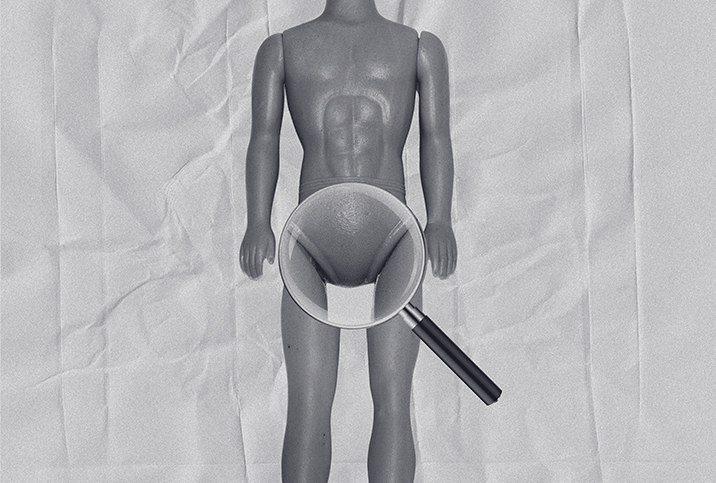I Can't See My Penis Anymore

Men's health problems are often misperceived as being exclusively straightforward. But birth conditions, genetics and life circumstances cause all kinds of problems directly and indirectly.
Not all penises belong to people born under the same circumstances, and in certain cases, those circumstances may include genetic or bodily differences. In fact, some men are born with genitalia that isn't as externally located as most people might associate with penile placement.
Buried penis—also called concealed or hidden penis—is different than a micropenis in that the organ is full-sized but "buried" and not fully visible due to weight or other issues.
Fortunately, many infantile cases of concealed penis eventually resolve themselves as a process of bodily growth. Some children may need minor or more invasive procedures.
Some males are affected by a buried penis in adulthood, and treating the condition isn't always straightforward. In adults, it is often associated with obesity, and some of the challenges of a concealed penis are likewise buried beneath the surface.
Is buried penis common?
"As a general perspective, concealed and/or buried penis is a very problematic thing for many men," said Matthew J. Mutter, M.D., a urologist and men's health clinician with LSU Healthcare Network in New Orleans.
Despite efforts in recent decades to curb the problem of obesity in the United States, the condition remains prevalent and problematic on personal and provider levels.
People who haven't lived with obesity, either personally or with a loved one, may not take into account the hygienic and sexual health complications caused by being overweight. But obesity can impact the body in many ways, and buried penis is just one of the more difficult ones to talk about for people who have the condition. Dealing with buried penis can also result in mental suffering, both in the short and long term.
"Concealed penis is something that you really only see in what I would term, and I guess from the BMI standpoint, morbidly obese men," Mutter said, referring to the body mass index, a measure of body fat based on height and weight. "So it becomes a hygiene issue. Sometimes it becomes a voiding dysfunctional issue, and honestly, it can really just turn into a self-esteem/body image issue."
While most cases of concealed penis in adults are associated with obesity, unique cases sometimes occur in infants and young people who have congenital abnormalities. Weak ligaments at the base of the penis, where it attaches to underlying structures, can be the cause. Other cases have been associated with scrotum-area swelling related to a collection of lymph fluid, which builds up and buries the penis much the same way as fat does.
How is buried penis treated?
The primary advice for patients with buried penis is to lose weight, said Wael Almajed, M.D., a urologist and sexual medicine specialist on fellowship with Tulane University in New Orleans.
"Generally, the rule is that if you lose 30 pounds, you can gain an inch of penile length," he said.
This advice might send readers running to the nearest gym for a membership, but it shouldn't be taken literally. For obese and morbidly obese men, losing weight has been proved to increase measurable (and perceived) penis size; other men won't realize such noticeable changes.
Buried penis is a very difficult condition for the patient and for some physicians to treat, Mutter said. He mentioned one patient who has a difficult time keeping the gential area clean and gets recurrent yeast infections.
"It's very painful, bothersome and it's embarrassing for him," Mutter said. "It's just a very difficult thing to fix. You're talking about a major reconstructive operation to help fix that."
For obese and morbidly obese men, losing weight has been proved to increase measurable (and perceived) penis size; other men won't realize such noticeable changes.
He said the procedure can be fraught with complications, but is beneficial for the patient in the right situations.
Almajed said a surgical procedure to remove the fat pad above the penis is often done by a plastic surgeon, or some urologists have trained themselves to do it. But not all cases of concealed penis can be treated with the same surgery, he said. Doctors may need to employ a lipectomy, an abdominoplasty, a skin graft or some other procedure depending on the cause and other conditions present.
Whether patients address the issue through weight loss or surgery, it's important to not delay treatment any longer than necessary. In some cases, success in one area may not eliminate the need for effort in another.
"They tend to have difficulty urinating; you know, the urine kind of becomes stagnated in that area," Almajed said. "A lot of times they have repeated fungal infections in that area because it's always wet and it's difficult to clean. So they do suffer, these patients, and sometimes they lose weight, but despite that, the excess skin conceals the penis and losing weight might not be enough."
Obesity and the myriad issues it creates can have an impact on reproductive function and viability, as well, so the suffering experienced by these patients can become cumulative with the more ground it covers.
Solutions for sexual health needs
Though it can be difficult to talk about genital or sexual function, especially when combined with obesity, it's important to be thorough with your doctor.
Your urologist and/or primary care doctor may be able to make hygiene or lifestyle suggestions to help prevent issues from accumulating. They may also be able to prescribe medicines or refer you to helpful food or activity resources in the fight against obesity. If you reach the point of needing surgery, it's often most comfortable to go through the process of getting that referral from a doctor you already know and trust and, ideally, who knows you and your unique needs.
Obesity and sexual health are both aspects of caring for our bodies that require some outside input as well as frequent monitoring, so if you don't already have resources available to help you manage your health proactively, be sure to look into securing primary care and sexual health services.


















